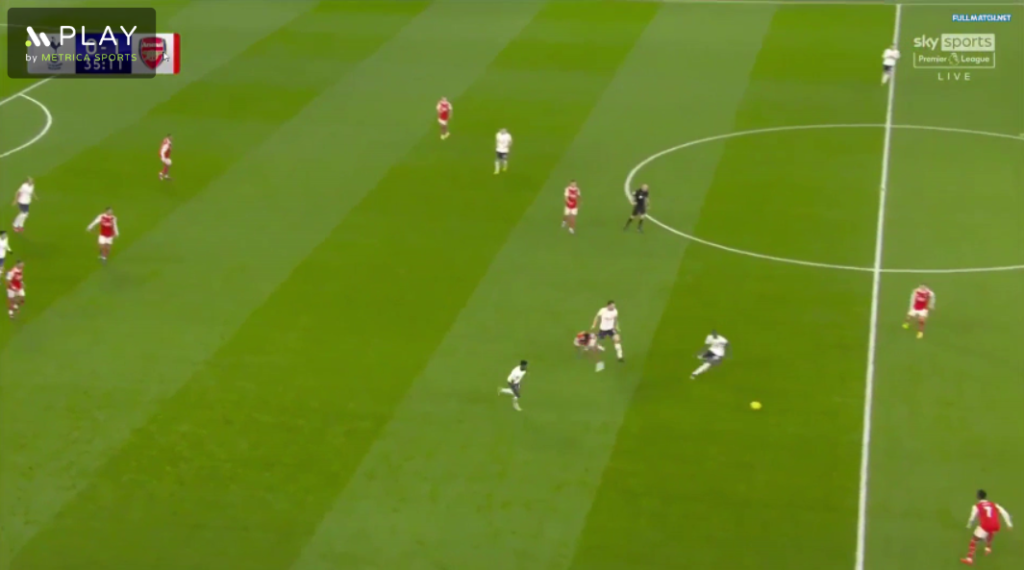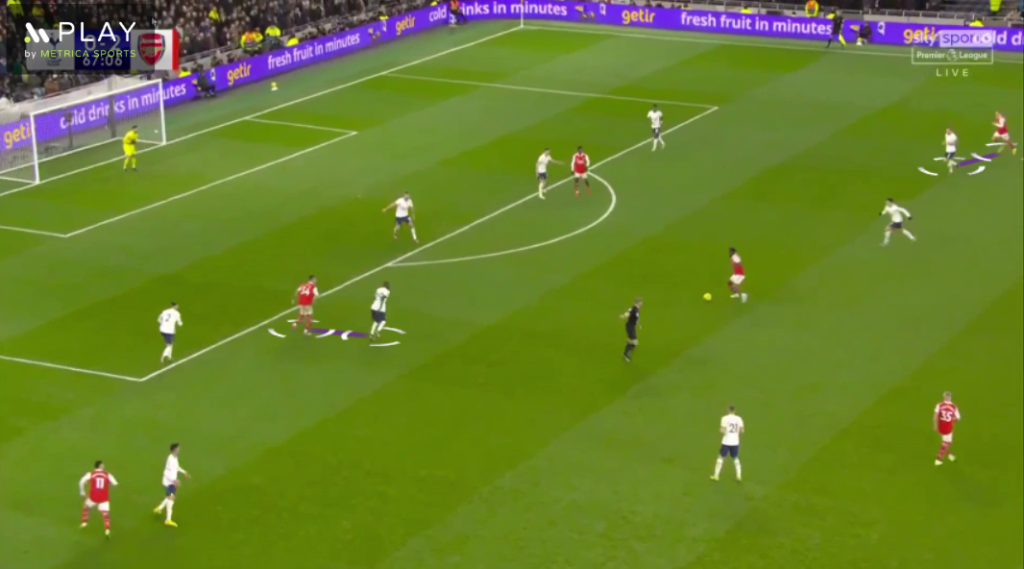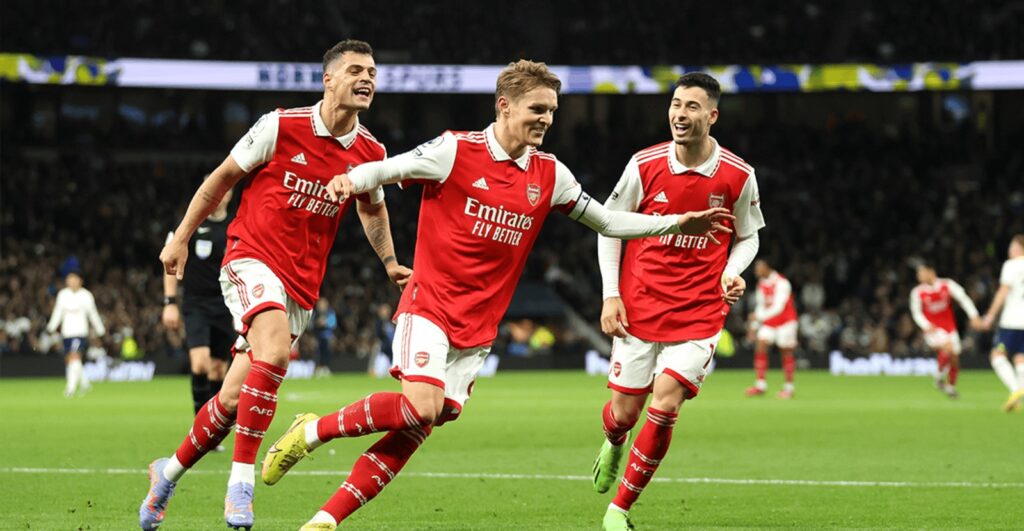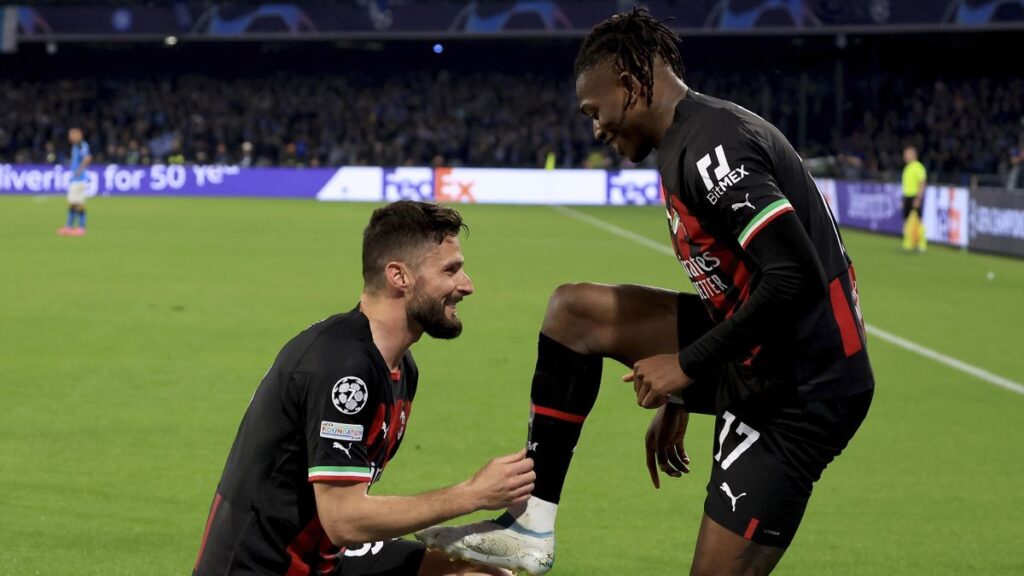In the 20th week of the Premier League, Tottenham and Arsenal faced each other in the North London Derby. In a week when Arsenal's biggest rival in the title race, Manchester City, dropped points, it was important for Arsenal to win the derby and extend their lead to 8. After Hugo Lloris' mistake and Martin Odegaard's stunning goal from outside the penalty area, Arsenal extended their lead in the league. The 11s of the two teams in the derby were as follows:

Arsenal In Possessıon
Arsenal had little to no difficulty in their build-up against Tottenham's disorganized high press and moved the ball forward with ease. Because of this, most of the match was played in Tottenham's half. The hosts' team length (the distance between the center-backs and strikers) was too long when they tried to press high. Their players at the back were unable to support the pressing up front, leaving big gaps in midfield for Arsenal players to exploit. Unable to prevent their opponents from moving the ball, Tottenham quickly retreated into their own half and started to defend deep.

In this position, Ramsdale easily passes the ball to B. White. Due to Saka's wide and forward positioning, the opposition left-back R. Sessegnon is unable to press and the Arsenal players find big gaps

In this position in the 35th minute, after a long ball from Lloris, Tottenham players come forward to regain the ball. Tottenham's team length is very long as you can see. The visitors make good use of the gaps in the middle and extend their lead to 2 as a result of this attack
Tottenham's defensive structure after retreating into their own half was more compact and effective. Lining up in a 5-4-1 formation in the deep and midfield, Tottenham allowed their opponents to possess the ball in their own half, but also limited the space in which they could play.

Tottenham's 5-4-1 defensive formation
ARSENAL'S USE OF ZONE 14
But Antonio Conte's choice of formation also had its inherent disadvantages. Arsenal's midfield trio of Partey, Odegaard and Xhaka outnumbered Tottenham's central duo (Hojbjerg and Sarr) 3v2. In order to make the midfield pairings, Tottenham center-backs would come out to the free player. In these moments there were big gaps between the lines.

Hojbjerg-Partey and Sarr-Xhaka pair up in the midfield. The free player is Odegaard. C. Lenget, playing on the left of the defensive line trio, therefore presses Odegaard

B. White sends the ball over Nketiah to Xhaka on the opposite flank. Arsenal shifts the play to the opposite flank and creates a scoring opportunity
When the Tottenham center-backs didn't press, another problem arose. If the ball was received by an open Arsenal midfielder, he would have too much space and time. Odegaard and Partey, who had the ball often in the match, posed a threat with shots from distance in these moments.

M. Odegaard and T. Partey's long distance shots from the 14th zone stood out throughout the match

Sarr covers Xhaka and Hojbjerg covers Odegaard. The free player, T. Partey, positions himself in "Zone 14". The player with the ball uses the space he has and tries a shot from distance, but it doesn't result in a goal

We see the same pattern again in Arsenal's 2nd goal. Hojbjerg and Sarr try to apply pressure on Partey up front and Saka receives the ball and passes to Odegaard. Nketiah's decoy run is also important here. His run behind the defense draws the centre-back deep and creates space for Odegaard

Sarr runs back quickly but can't stop Odegaard's run. The star player puts the ball into the bottom right corner of the net to put his team 0-2 up in the derby
ZINCHENKO'S CONTRIBUTION TO ARSENAL
Oleksandr Zinchenko was another factor that challenged Tottenham's defense. Having played as a midfielder earlier in his career, he has a high level of technique for a left-back. In this match, Zinchenko, who often came inside to overload the midfield, caused another problem for Tottenham players who were already struggling with match-ups. He helped his team to break down the opposition's defensive structure and also contributed to his team's ball circulation.
WIDE TRIANGLES AND 2-3-5
So how did Arsenal line up when they brought the ball into the final third? When the away team successfully moved the ball into the final third, we saw a 2-3-5 formation. Arsenal attacked with a 5-man rest-defense structure, thus ensuring defensive security. Especially against a team like Tottenham, who are very good when it comes to transitions, it was very important to prevent counter-attacks. On both sides of the pitch, the wingers were usually the ones providing width, with occasional rotations between Zinchenko and Xhaka on the left. If one of these players with a high level of positional knowledge entered the other's area, the other player would fill the gap. In other words, if Zinchenko was the player giving width, Xhaka would stay further back and ensure that the rest-defense structure was not disrupted.

Although the centre-backs are not in the frame, we can see the 2-3-5 structure very clearly
Another advantage of this structure was the triangles that emerged in wide areas. These triangles formed by the fullback-number 8-winger trio ensured that Arsenal did not lose the ball easily. When the ball came to the winger, if there was a situation that could be exploited (such as 1 v 1 with the opposition fullback), the winger could take advantage of it by dribbling or crossing. If Tottenham, as a team, shifted well and didn't leave empty space, the ball would go to the full-back and the attack would continue down the opposite flank. The player at the back secures the defense, the player on the line stretches the opposing team, and the player between the full-back and the center-back creates a passing option in the dangerous area.

In this position we see the Xhaka-Zinchenko rotation once again. Normally Martinelli gives the width on the left side, but when Zinchenko moves to the wing, Martinelli moves inside and Xhaka positions himself further back

In this position on the other side of the pitch, it is Saka who gives the width, B. White who helps Arsenal keep the possession and M. Odegaard who takes up position in the half-space
TOTTENHAM IN POSSESSION
Tottenham had serious problems with using the ball productively, especially in the first half. Naturally, Arsenal's pressing up front also had an effect on this. With his 2nd half substitutions, Antonio Conte stabilized the game a bit more, but couldn't prevent the defeat.
ARSENAL'S ASYMMETRICAL HIGH PRESS
While Tottenham were in the build-up phase, Arsenal faced their opponents with a narrow structure. All passing connections with the players in the midfield were cut off, the opponent was directed to the flank and the ball was won there. During the pressing, Martinelli was further forward than B. Saka on the opposite flank. There was a reason for Martinelli doing this, as he was covering right center-back C. Romero instead of right full-back Doherty. If Tottenham players somehow got the ball to M. Doherty, left-back Zinchenko would come and apply pressure. This meant that 1v1 matches would emerge at the back. The reason why Arsenal had no problems in these moments was their right-back B. White. The player with centre-back origins, came inside when Zinchenko went to press, creating a formation with 3 center-backs. Winning 3 out of 4 air balls, B. White ensured that his opponent couldn't take advantage of the 1v1 match-ups. If Saka had pressed the center-back and not Martinelli, Sessegnon would have been left open and B. White would have pressed him. There would have been 1v1 matches at the back once again, but in this scenario, Zinchenko, whose air ball skills are weaker than B. White's, would have been the player standing next to the centre-backs. This would have allowed Tottenham to take advantage of the situation. Mikel Arteta must have thought about this before the game, as this scenario did not play out.

Arsenal's pressing pattern. Xhaka-Sarr and Partey-Hojbjerg match-ups in midfield. Nketiah is marking Dier closely. Martinelli and Odegaard are pressing the centre-backs. Saka and Zinchenko, who are not in the frame, are marking the wing-backs. We see Arsenal's narrow structure and how they direct the opposition to the flanks

When Zinchenko goes to press Doherty, there are 1v1 match-ups at the back. The fact that all 3 players at the back are skilled in aerial balls prevents Tottenham from capitalizing on these match-ups

In this situation Lloris plays long to Doherty at the goal kick. This pass triggers Zinchenko and he comes out to press. Meanwhile, right-back B. White shifts towards the inside. At the same time, Odegaard leaves Lenget to mark Hojbjerg. This allows Partey to go deeper and close down the midfield

Arsenal players who are close to the ball are all pressing and all trying to get the ball in a compact way. With Nketiah shifting inside, the pressure is now 4v3
PREVENTING NUMERICAL SUPERIORITY
When Tottenham moved the ball into the final third, Arsenal had a different structure. Arsenal switched to a five-man defense to prevent the home team's five-man attacking line from establishing numerical superiority, with Odegaard taking position alongside Nketiah and Martinelli alongside Xhaka and Partey. Thus, a 5-3-2 formation was formed. The reason for Arsenal's effectiveness in the deep block was that they defended in a very compact manner. With almost no space between the lines, the away team had a very short team length.

As can be seen, Tottenham are not allowed to attack through the middle. With Zinchenko, the full-back on the far side, coming closer to the center, the Arsenal players positioning is rather compact

The short length of the team stands out. Tottenham have limited space to work with
The BUKAYO SAKA EFFECT
One of the tactical choices that stood out in the match concerned Arsenal right winger Bukayo Saka. We mentioned above that Arsenal reverted to a 5-man defense in the deep block. Of course, in order to do that, they had to have enough material at their disposal and fortunately they had it. Bukayo Saka, who has often played as a wing-back in the past, had a special role in the match. When Arsenal had the ball, he was wide and high, and when the opposition had the ball, he closely marked Sessegnon. The hard-working winger performed this task to near perfection, which helped his team avoid defensive vulnerabilities.

A long ball behind the defense, Saka follows Sessegnon to his own penalty area and contributes to the team defense
Aaron Ramsdale deserves a special mention here. Although Arsenal controlled the game, Tottenham players also had some clear goal scoring chances, especially in the second half, but were denied by Ramsdale. He played one of his best games for Arsenal and was one of the players who brought his team the win.
Conclusıon
Tottenham's inconsistent form continued with this game, while Arsenal got three very important points in the title race. Tottenham could have used Bissouma and the 5-3-2 formation that they have used a few times this season, securing match-ups in the midfield. With the 2nd half substitutions, they were a bit more in the game, but it wasn't enough for a comeback and Arteta was tactically the winner of the derby.



